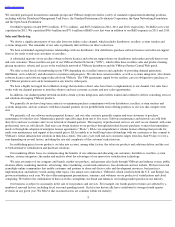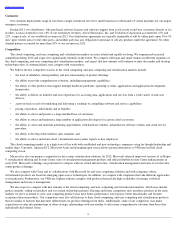VMware 2012 Annual Report Download - page 20
Download and view the complete annual report
Please find page 20 of the 2012 VMware annual report below. You can navigate through the pages in the report by either clicking on the pages listed below, or by using the keyword search tool below to find specific information within the annual report.
Table of Contents
However, if our overall selling strategy is not successful, our growth rates may decline further, and our business, financial condition and
results of operations could be materially adversely affected.
Our sales cycles can be long and unpredictable, our sales efforts require considerable time and expense and timing of sales is subject to
changing purchasing behaviors of our customers. As a result, our sales are difficult to predict and may vary substantially from quarter to
quarter, which may cause our operating results to fluctuate significantly.
The timing of our revenues is difficult to predict. Our sales efforts involve educating our customers about the use and benefit of our
products, including their technical capabilities, potential cost savings to an organization and advantages compared to lower-
cost products offered
by our competitors. Customers typically undertake a significant evaluation process that has in the past resulted in a lengthy sales cycle which
typically lasts several months, and may last a year or longer. We spend substantial time, effort and money on our sales efforts without any
assurance that our efforts will produce any sales. In addition, product purchases are frequently subject to budget constraints, multiple approvals,
and unplanned administrative, processing and other delays. Moreover, the greater number of competitive alternatives, as well as announcements
by our competitors that they intend to introduce competitive alternatives at some point in the future, can lengthen customer procurement cycles,
cause us to spend additional time and resources to educate end users on the advantages of our product offerings and delay product sales.
Economic downturns and uncertainty can also cause customers to add layers to their internal purchase approval processes, adding further time to
a sales cycle. These factors can have a particular impact on the timing and length of our ELA sales cycles.
Additionally, our quarterly sales have historically reflected an uneven pattern in which a disproportionate percentage of a quarter’s total
sales occur in the last month, weeks and days of each quarter. Similarly, our yearly sales have historically reflected a disproportionate percentage
of the year’s sales in the fourth fiscal quarter. These patterns make prediction of revenues, earnings and working capital for each financial period
especially difficult and uncertain and increase the risk of unanticipated variations in financial condition and results of operations. We believe this
uneven sales pattern is a result of many factors including the following:
If sales expected from a specific customer for a particular quarter are not realized in that quarter or at all, our results could fall short of
public expectations and our business, financial condition and results of operations could be materially adversely affected.
We are dependent on our management and our key development personnel, and the loss of key personnel may prevent us from implementing
our business plan in a timely manner.
Our success depends largely upon the continued services of our existing management. We are also substantially dependent on the continued
service of our key development personnel for product innovation and timely development and delivery of upgrades and enhancements to our
existing products. The market for expert software developers upon whom we rely has become increasingly competitive. We generally do not
have employment or non-compete agreements with our existing management or development personnel, and, therefore, they could terminate
their employment with us at any time without penalty and could pursue employment opportunities with any of our competitors. Changes to
management and key employees can also lead to additional unplanned losses of key employees. The loss of key employees could seriously harm
our ability to release new products on a timely basis and could significantly help our competitors.
Because competition for our target employees is intense, we may not be able to attract and retain the highly skilled employees we need to
support our planned growth, and our compensation expenses may increase.
To execute on our strategy, we must continue to attract and retain highly qualified personnel. Competition for these personnel is intense,
especially for senior sales executives and engineers with high levels of experience in designing and developing software. We may not be
successful in attracting and retaining qualified personnel. We have from time to time in the past experienced, and we expect to continue to
experience in the future, difficulty in hiring and retaining highly skilled employees with appropriate qualifications. Many of the companies with
which we compete for experienced personnel have greater resources than we have. R&D personnel are also aggressively recruited by startup and
emerging growth companies, which are especially active in many of the technical areas and geographic regions in which we conduct product
development. In addition, in making employment decisions, particularly in the high-technology industry, job candidates often consider the value
of the stock-based compensation they are to receive in connection with their employment. Declines in the value of our
18
•
the tendency of customers to wait until late in a quarter to commit to a purchase in the hope of obtaining more favorable pricing;
• the fourth quarter influence of customers spending their remaining capital budget authorization prior to new budget constraints in the
first nine months of the following year; and
•
seasonal influences, such as holiday or vacation periods.
























